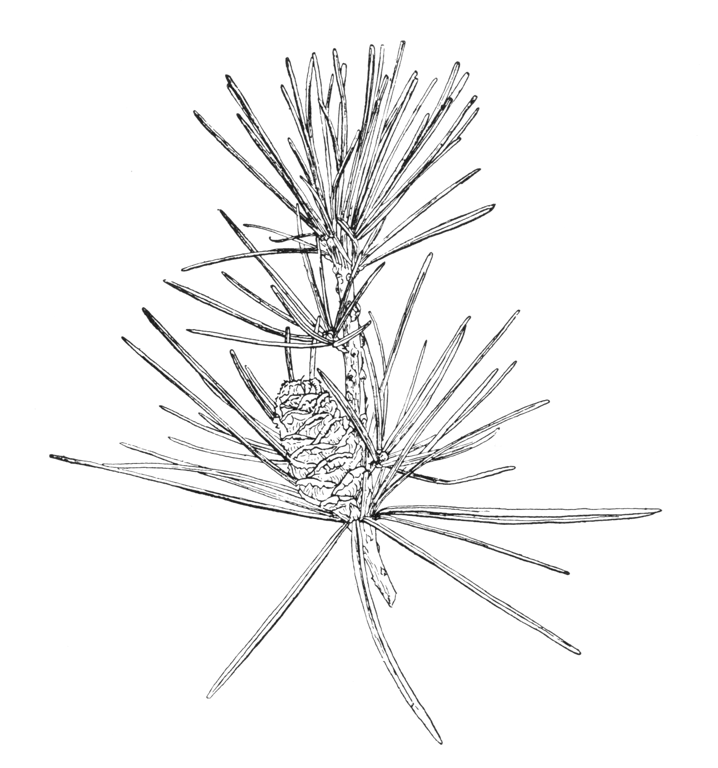An evergreen tree attaining a height of 120 ft in its native forests, and with a girth there of up to 15 ft; bark reddish brown, shed in narrow vertical strips; branchlets brown, glabrous, bearing minute scale-leaves, scattered in the lower part, crowded at the apex of the shoot into two or three imbricating rows, where each subtends a leaf (by some interpreted as a cladode, see introductory note). Leaves in whorl-like clusters, persisting for about three years, 2 to 5 in. long, about 1⁄8 in. wide, slightly narrowed at top and bottom, minutely notched at the apex, dark green and slightly grooved above, lower surface paler, deeply grooved, with a white or yellowish line of stomata running along the groove. Male flowers in a raceme about 1 in. long. Cones 2 to 3 in. long, 1 to 2 in. wide, borne on a stout stalk; scales with broad reflexed margins. Bot. Mag., t. 8050.
Native of Japan; introduced by J. G. Veitch in 1861 by means of seeds, but Fortune sent young plants to Standish’s nursery in the same year, one of which was exhibited to the Royal Horticultural Society on June 5, a few days after its arrival from Japan. In 1853 Thomas Lobb had sent a single plant to Veitch’s Exeter nursery, which he had obtained from the Buitenzorg Botanic Garden in Java, but that was sickly on arrival and soon died.
The popular name for this conifer (and its generic name) refers to the arrangement of the leaves, which resemble the ribs of an umbrella. This remarkable and beautiful tree ‘stands alone amongst Coniferae with no obvious affinities or immediate allies, and must be conjectured to have come down to us from a remote geological past which had obliterated all trace of its immediate ancestors.’ (Thistleton-Dyer). Species of Sciadopitys occurred in Europe in the Tertiary and indeed were so common in Germany in the mid-Tertiary that the leaf-remains give a characteristic appearance to some layers of brown coal (Magdefrau, Paläobiologie d. Pflanzen, ed. 3 (1956), p. 356).
In gardens the umbrella pine is usually seen as a shrub or small tree, often many-stemmed from the base. What should perhaps be regarded as the forest form is less common, but any well-grown specimen is striking and ornamental. It should have an isolated position and thrives in a warm, lime-free soil. It is very hardy, but grows slowly when young.
cv. ‘Pendula’. – In Forest Flora of Japan (1894), p. 78, Sargent observes that there is a remarkable tree with pendulous branches in the Shiba Park, Tokyo. A tree of similar habit used to grow in Gunnersbury Park, London (S. vert. var. pendula Bean).
The finest example of S. verticillata known to Elwes and Henry grew at Hemsted, Kent, in the grounds of what is now Benenden School. In 1905 it measured 38 × 2 ft; it is now 74 × 43⁄4 ft (1970) and still as then a slender spire (cf. Tr. Gt. Brit. and Irel., Vol. III, plate 159b). Others measured recently are: R.H.S. Garden, Wisley, 49 × 23⁄4 ft (1971); Tilgate Park, Crawley, Sussex, pl. 1905, 56 × 43⁄4 ft (1975); Leonardslee, Sussex, 55 × 31⁄4 ft (1966); Sheffield Park, Sussex, 50 × 41⁄2 ft (1974); Bodnant, Denbighs., pl. 1901, 56 × 41⁄2 ft (1974); Kilmory Castle, Argyll, 42 × 51⁄2 ft (1976); Castlewellan, Co. Down, 37 × 43⁄4 ft (1976); Curraghmore, Co. Waterford, Eire, 46 × 53⁄4 ft (1975).


